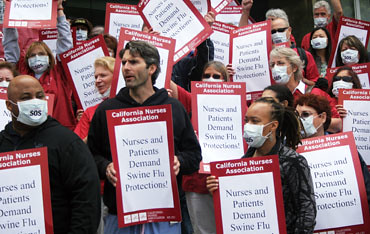Far and away the most exciting industry for the labor movement today is healthcare-and the air of historic change was in the San Francisco air this week as more than 1,200 registered nurses from across the country gathered to plan their coming merger…and to advance their patient advocate’s agenda of guaranteed healthcare on the single-payer model and of genuine labor law changes to allow every nurse to freely choose her union. The RNs are members of the California Nurses Association/National Nurses Organizing Committee, and their guests from United American Nurses and Massachusetts Nurses Association.
The 1,200 nurses broke from their meeting to make a special house call to Dianne Feinstein, and deliver roses along with hand-written pleas for her to support the Employee Free Choice Act. She’s in DC, but we’re sure she’ll get the message that we expect her to help nurses join unions and save lives. That change alone will significantly improve our healthcare system.
Meanwhile:
In These Times reports on the coming RN SuperUnion and how registered nurses, together with the muscle of the AFL-CIO, will have the ability to inject a humane and pro-patient politics into our policy:
While lawmakers bicker and the public wades through a muddle of misinformation, the major nurses unions, particularly the California Nurses Association (CNA), are staking out bold positions on reform. Their efforts have culminated in a new union merger that seeks to align progressive nurses with other service workers as well as healthcare consumers.
As a critical link between physicians and patients, nurses occupy a pivot point in the reform debate. Alongside bread-and-butter campaigns on pandemic-flu preparedness and nurse-to-patient staffing ratios, the CNA has taken on universal healthcare as a labor issue, arguing that single-payer would not only serve patients’ best interest, but also make the entire system more economically viable.
The Wall St. Journal writes up how these pro-patient policies lead to nurses pushing Obama for better healthcare proposals:
At a conference for registered nurses in San Francisco, Geri Jenkins watched President Barack Obama’s televised speech with several others from the California Nurses Association. After the speech ended, the knot of nurses was left disappointed.
“You have to give him credit for standing up and trying to tackle the problem,” Jenkins said after it was over. “But it just needed to go a step further.”
Jenkins would have liked to see Obama’s plan place greater restrictions on how much insurance companies can charge consumers. Her 29-year-old stepdaughter, who was born with a heart condition, has gone without health insurance for a year because she could no longer afford the $7,000 annual catastrophic coverage.
Other nurses also felt the president’s proposals did not go far enough.
The San Francisco Chronicle let CNA/NNOC executive director sum it up:
“The problem with other solutions like the public option is that they leave in place the real problem: The insurance companies,” DeMoro told us.
As the Washington Independent reports, those insurance companies are the subject of a new investigation by California Attorney General (and future and past Governor) Jerry Brown, after CNA/NNOC uncovered data that they reject on average 22 percent of all claims-and that jumps to 40 percent for the worst company, PacifiCare.
While the Christian Science Monitor notes the ongoing viability of the single-payer reforms nurses are dedicated to…it’s popular in the states and HR 3200 contains an amendment to empower states to that kind of experimentation:
The California Nurses Association was also instrumental in lobbying for an amendment, added by Rep. Dennis Kucinich (D) of Ohio to a House version of the federal healthcare reform bill, that would remove potential legal impediments for states to pass single-payer bills by waiving federal exemptions that apply to employer-sponsored health plans from the federal Employee Retirement Income Security Act (ERISA)…. There are also strong prospects for single-payer healthcare in California, where the legislature has twice passed single-payer, only to have it vetoed both times by Governor Schwarzenegger.
Next week, we’ll be taking the fun to Pittsburgh where we will host the U.S. premiere of Michael Moore’s Capitalism: A Love Story at the national AFL-CIO convention, and use the occasion to throw a huge single-payer party
Check out more pix here.


